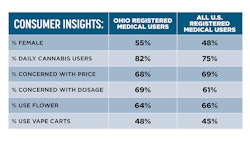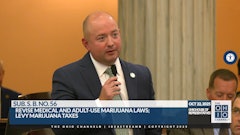
As Phil Niles, executive vice president of GreenSeal Cannabis Co., a licensed cannabis producer in Stratford, Ontario, looks back on the five years since Canada launched adult-use cannabis sales on Oct. 17, 2018, he says legalization has been the most successful for consumers.
“The consumers are the big winners,” he tells Cannabis Business Times. “They’ve got more choice, more access than ever, thousands and thousands of products at their disposal, pretty good sector coverage, [and] pricing … is fantastic for the quality and the safety [they’re getting]. So, I think it's been a resounding success for the customer.”
Legalization has also been relatively successful for governments, Niles says, as they have stood up a market that contributes billions of dollars per year to the economy and made progress on their goal of diminishing Canada’s unregulated cannabis market.
The ones enjoying perhaps the least amount of success are current and prospective business owners, many of whom are currently surviving rather than thriving under less-than-ideal economic conditions.
“I think the big losers in all of this have obviously been investors and operators,” Niles says. “It’s an incredibly cutthroat space.”
Alexandre Gauthier, vice president of R&D and director of cultivation for Quebec-based licensed producer (LP) Origine Nature, says that while operating in a tightly regulated industry like cannabis can be challenging, understanding the regulations and building a proper business can help operators find success.
“You can’t just have a good grower,” Gauthier tells CBT. “You need a good grower, and you need a good bureaucratic team behind it to deliver the product to market. If one of the two doesn’t work, your company won’t work. I’ve seen a lot of people that never bothered to read the Cannabis Act or cannabis regulations.”
Gauthier says the first few years of legalization, from roughly 2018 to 2020, were especially difficult, in part due to poor business decisions that led to an excess of cultivation space and an oversupply of cannabis that far exceeded consumer demand.
“A lot of what we saw were basically business plans based on the simple idea that if you grow cannabis, people are going to throw money at you to buy it,” Gauthier says. “I’ve seen mostly people not understanding the workflow. It’s all about the cost of production systematically. When the product is good, the price is too high. … You can be a micro-LP and have very good cannabis, but if your cost of production is too high because your techniques don’t make sense and they’re not scalable, well, you can't release the product at the right price.”
When “Cannabis 2.0” products, including edibles, extracts and topicals, became legal exactly one year after adult-use legalization—on Oct. 17, 2019—they began to rise in popularity and attract new consumers, Gauthier says, although flower continues to dominate the market and the preroll category has experienced significant growth in recent years.
RELATED: Prerolls Surge in Popularity, Offering Opportunity in Mature Markets
“Overall, legalization was, for me, very positive,” Gauthier says. “Anybody that wants to legalize something and is hoping for the first five years to be magical and perfect has a lot of illusions. … When we’re doing something new, we’re going to miss some steps and it’s part of life to fall down [and] get back up. So, overall, in five years, there’s definitely more normalization, there’s more education [and] there’s a lot more people consuming safe cannabis.”
Operators that provide consistent products that offer the experience consumers are looking for will always come out ahead, Gauthier says.
“Ego, bureaucratic pressure, delivery to market, understanding consumers and having the right workflow to put the product at the right price—that’s really where I find that people struggle to be profitable,” he says.
A First Step Toward Change
Health Canada announced in September 2022 that it would launch a review of the Cannabis Act, Canada’s adult-use legalization law, to evaluate its impact on youth, indigenous communities, the economy, the illicit market and more.
The review was required by the Cannabis Act itself, which directed Canada’s health minister to conduct a review of the legislation three years after it took effect in October 2018.
The resulting study, conducted by an Expert Panel appointed by government officials, launched a year later than planned. All Canadians were invited to share feedback on adult-use cannabis legalization through an online questionnaire or written feedback, with all comments due by Nov. 21, 2022.
The Expert Panel was then responsible for advising Health Minister Jean-Yves Duclos and Carolyn Bennett, Minister of Mental Health and Addictions and Associate Minister of Health, on the progress made toward achieving the Cannabis Act’s goals and identifying areas of improvement in the law.
Health Canada published a “What We Heard” report Oct. 10 that outlines the findings of the legislative review. When it comes to the overall health of businesses in the industry, the report declared what Niles and many other operators already knew—that many businesses are struggling to turn a profit and become financially viable due to the often steep costs of taxes, markups, fees and regulatory compliance.
RELATED: Canadian Government Releases Report on Legislative Review of Cannabis Act
Niles says he wasn’t surprised by anything noted in the report and describes many of the Expert Panel’s findings as “plainly obvious” observations of Canada’s cannabis landscape.
“Just because it’s obvious to the people in the industry, it might not be obvious to the regulators or to the governmental bodies or to other stakeholders in the space,” he says. “I think the report was good in the sense that it's flagging these things.”
The Expert Panel noted that the What We Heard Report marks the completion of the first phase of regulators’ efforts to evaluate and reform the Cannabis Act. For the second phase of its work, the panel plans to host roundtables and additional discussions with industry stakeholders to further understand the complexities of the market. The panelists will then prepare a final report for the ministers that will be tabled in Parliament by March 2024 with advice and recommendations that the government can then act on.
Niles found some aspects of the panel’s preliminary report particularly encouraging, including a mention of a minimum price for cannabis.
“For a lot of producers, this is actually the biggest problem, is that the current market price in the legal market is below the cost to produce that product,” he says. “And at least here in Ontario, there’s precedent for that already. There’s already minimum pricing for alcohol, for example, in Ontario. So, that is one [recommendation] … that makes a lot of sense. It’s something that can help guarantee a floor. … It’s good for retailers, as well, and it prevents some of the more aggressive market manipulative pricing that you see from some of the larger cannabis players who can only function on scale and not on market pricing.”
Niles also agrees with the report’s assessment of progress made toward diminishing unregulated cannabis sales.
The Expert Panel noted in the report that more than half and up to as much as three-quarters of cannabis is now being purchased from legal sources in Canada; the panelists cited a 2022 survey that found 63% of cannabis users always or mostly accessed legal sources, for example.
“That was one of the major goals for the group, was to shut out that black market, to cut off the elements of that,” Niles says. “And it was nice to see that they feel that they’ve made some good headway into that. I would agree that they’ve made good headway, but [there’s] still some work to be done. I liken it metaphorically to illegal downloads of movies and music. … If you rewind the clock to the late nineties, downloading illegally was everywhere. And then you get an iTunes introduced and you get new streaming services, … and slowly over time that black market for illegal downloads has basically dried up at this point.”
Combatting illegal cannabis sales remains in the early stages, he says, but he expects the unregulated market to continue to diminish as legal access improves in remote communities and as different product formats and potencies are reevaluated.
Unanswered Questions
Niles says the major focus now is what final recommendations the Expert Panel will make to Canada’s government regarding potential policy changes.
“It’ll be very interesting to see what the specific recommendations are, and then, of course, what actions are actually taken by the government to introduce those recommendations to help the market.”
Taxes have been a topic of debate among Canada’s licensed producers, with many arguing that the tax burden—the federal excise tax is set at a minimum of CA$1 per gram on fresh and dried cannabis, regardless of the average wholesale cannabis price, for example—is too high in the legal market and contributes to many operators’ financial woes.
“A main message from industry representatives was that, despite the growth of the legal cannabis market, companies across the supply chain are struggling to realize profits and maintain financial viability,” the Expert Panel wrote in the report. “Specifically, they noted that the hyper-competitive cannabis market for producers and retailers, combined with the various regulatory fees, distributor markups and fees, and taxes are stifling companies of all sizes. Some noted that other industries, such as alcohol and tobacco, are not subject to federal regulatory fees and that they pay less markups and taxes (for example, beer). Some stakeholders proposed that Health Canada move towards an ‘à la carte’ model for regulatory fees (that is, transactional fees for specific services) and remove the annual regulatory fee. Others felt that the government should adopt a progressive excise tax framework, whereby the tax rate is connected to the size of the firm or the price of the product. Others suggested adjusting the tax rate to 10% for dried cannabis, as opposed to the current model of $1 or 10% per gram, whichever is greater.”
Gauthier says he has an “unpopular opinion” about taxes and argues for keeping taxes the same but using the revenue generated more efficiently.
“We want to get taxed, and we want that money to be used the right way,” he says. “It’s not about being taxed; it’s about putting pressure on the government to use all the money generated from cannabis to make a better tomorrow for our country, which is not happening right now.”
Niles says he’s hopeful that regulatory changes may be enacted by the end of 2024, but he expects the larger impacts of those changes to take more time to affect Canada’s cannabis industry.
If the government were to eliminate the potency caps on cannabis edibles, for example, Niles says companies must then get regulatory approvals for new products, formulate those products, and get them to market, all of which takes time. The same concept applies to opening additional dispensaries and improving access in more remote areas of the country.
“You can't just snap your fingers and open a store,” Niles says. “That will take time, too, to push that out. … The stores are licensed by the provincial level, so even if the federal government says, ‘Yeah, we need more stores in Quebec,’ it’s still up to the Quebec government to actually go do that. So, these things will all take time to filter through the system. I think anyone looking for very quick fixes will be disappointed, but the nature of government and the nature of the regulators is they’re not necessarily moving to appease the here and the now. They’re trying to build a safe and stable industry over the long run, and they’re going to take a long-run view. Hopefully change is coming. It just might not be what people want or as quickly as they want it.”
RELATED: Tight on Time: Can Canada’s Licensed Producers Hang On?
In any case, Niles stresses that change is urgently needed to save some businesses that have been surviving rather than thriving due to difficult economic conditions.
“Clearly profitability was flagged throughout the report as a major, major issue, and it absolutely is a major, major issue when even the best operated companies and the most efficient companies, they’re barely getting by,” he says. “They’re just squeezing out profit, if they’re squeezing out profit at all. That’s not the recipe for success. The first five years have been great for a bunch of groups, but at the end of the day, if it’s not sustainable from an economic perspective, there will not be an industry … because it’s not sustainable.”
‘A Real Industry’
Overall, five years post-legalization, Niles and Gauthier say the industry has become more normalized.
“Normalization is what’s important,” Gauthier says. “We still see a huge stigma—unfortunately very, very, very big. We’re starting to get there, and I think people are starting to understand that the actual mission is normalization, not education, because where education [comes in] is in five years. … I understand we like cannabis, and we understand cannabis, but that’s not the case for most people buying from us. And so, we're slowly moving in the right direction.”
This is evidenced, Niles says, not only by how many stakeholders participated in the legalization review and provided feedback, but also by many of the worst-case scenarios of adult-use cannabis failing to materialize in the past half-decade.
“I think it goes to show how mainstream cannabis has become in Canada that more and more industries that maybe sat on the side are getting more involved, or at least taking a more active approach,” he says. “I think a lot of people can admit now that the worst-case scenarios have not even come close to materializing. We haven’t seen disaster public health consequences. We haven’t seen ridiculous increases in impaired driving. … So, I think the good news is that some of the worst fears are off the table. I think a lot of people are now engaging with this space, saying, ‘OK, this is a thing. This is a real industry now. This is a real business that will have real impacts on society, and let’s have our say in how that society treats this industry.’ And I think that’s great to have more people at the table.”
As one of the first countries to federally legalize cannabis for adult use, Canada is largely recognized as a leader in the space and has plenty of lessons for others looking to implement federal cannabis policy reform.
“You do see a whole bunch of countries looking to Canada as a thought leader on this space, and Canadian companies and individuals becoming globally valued thought leaders on this emerging and uniquely complicated and growing space,” he says. “I think in a lot of ways there’s been a big win.”
Gauthier echoes Niles’ sentiment and adds that Canada will likely be a large exporter of cannabis as more countries legalize around the world.
“I think that Canadian legalization is for the moment the best,” he says. “A lot of countries are starting to understand the power requirements and ecological requirements and all the bureaucratic requirements of legalizing cannabis. A lot of them are seeing that it’s probably going to be easier to import from Canada than to produce locally. It’s really going to put us in a position of global experts, and I really think that we’re going to see a lot of money come true from there. It’s really going to help Canada’s overall economy, and if all of the tax money that’s generated from cannabis is used the right way, [it] definitely will usher Canada in its next step in super economic development.”
Niles also applauds the government for taking the time to address public safety in the rollout of adult-use sales.
“The government, in my opinion, did it right,” he says. “They swung the pendulum towards safety and stability in their rollout, … but now they need to normalize. … The industry itself needs to normalize, and everyone needs to play their part to say, OK, we can’t have people infinitely footing the bill on this industry with investment dollars. It needs to be self-sustaining in some way, shape or form for it to keep going. I think that’s where the attention needs to be drawn at this point. I think consumers have definitely got what they wanted. Governments have largely got what they wanted, or at least they’re on the path to that. So, now I think it’s, how do you represent the commercial interests of this space to ensure that it’s a space that’s around?”
RELATED: Cannabis Council of Canada Calls on Government to Save Struggling Industry
Niles believes that the government and regulators understand the issues at hand and have a vested interest in resolving them to preserve the jobs and tax revenue that the industry has created over the past five years.
“I’m hopeful that there’s change, and I’m hopeful that some of those issues are addressed,” he says. “I have no doubt that this industry will normalize. It’s just how long and at what costs? How long will it take, and at what cost to get there in terms of businesses?”
In the meantime, Niles is taking a moment to celebrate five years of legalization.
“It’s unbelievable that it’s five years, actually,” he says. “In some ways, it’s felt like an eternity. And in some ways, it’s absolutely lots of work yet to come, but it's an important milestone for sure.”


























